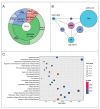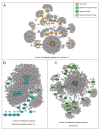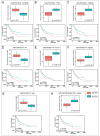Bioinformatics Prediction and Machine Learning on Gene Expression Data Identifies Novel Gene Candidates in Gastric Cancer
- PMID: 36553500
- PMCID: PMC9778573
- DOI: 10.3390/genes13122233
Bioinformatics Prediction and Machine Learning on Gene Expression Data Identifies Novel Gene Candidates in Gastric Cancer
Abstract
Gastric cancer (GC) is one of the five most common cancers in the world and unfortunately has a high mortality rate. To date, the pathogenesis and disease genes of GC are unclear, so the need for new diagnostic and prognostic strategies for GC is undeniable. Despite particular findings in this regard, a holistic approach encompassing molecular data from different biological levels for GC has been lacking. To translate Big Data into system-level biomarkers, in this study, we integrated three different GC gene expression data with three different biological networks for the first time and captured biologically significant (i.e., reporter) transcripts, hub proteins, transcription factors, and receptor molecules of GC. We analyzed the revealed biomolecules with independent RNA-seq data for their diagnostic and prognostic capabilities. While this holistic approach uncovered biomolecules already associated with GC, it also revealed novel system biomarker candidates for GC. Classification performances of novel candidate biomarkers with machine learning approaches were investigated. With this study, AES, CEBPZ, GRK6, HPGDS, SKIL, and SP3 were identified for the first time as diagnostic and/or prognostic biomarker candidates for GC. Consequently, we have provided valuable data for further experimental and clinical efforts that may be useful for the diagnosis and/or prognosis of GC.
Keywords: diagnostic genes; disease genes; gastric cancer; multi-omics; prognostic genes; systems biology.
Conflict of interest statement
The authors declare no conflict of interest.
Figures






Similar articles
-
Gastric Cancer Biomarker Candidates Identified by Machine Learning and Integrative Bioinformatics: Toward Personalized Medicine.OMICS. 2023 Jun;27(6):260-272. doi: 10.1089/omi.2023.0015. Epub 2023 May 25. OMICS. 2023. PMID: 37229622
-
Bioinformatics Analysis and Validation of Potential Markers Associated with Prediction and Prognosis of Gastric Cancer.Int J Mol Sci. 2024 May 28;25(11):5880. doi: 10.3390/ijms25115880. Int J Mol Sci. 2024. PMID: 38892067 Free PMC article. Review.
-
Integrated profiling identifies SLC5A6 and MFAP2 as novel diagnostic and prognostic biomarkers in gastric cancer patients.Int J Oncol. 2020 Feb;56(2):460-469. doi: 10.3892/ijo.2019.4944. Epub 2019 Dec 16. Int J Oncol. 2020. PMID: 31894266 Free PMC article.
-
Identifying Diagnostic and Prognostic Biomarkers and Candidate Therapeutic Drugs of Gastric Cancer Based on Transcriptomics and Single-Cell Sequencing.Pathol Oncol Res. 2021 Nov 25;27:1609955. doi: 10.3389/pore.2021.1609955. eCollection 2021. Pathol Oncol Res. 2021. PMID: 34899080 Free PMC article.
-
Review of recent molecular landscape knowledge of gastric cancer.Histol Histopathol. 2018 Jan;33(1):11-26. doi: 10.14670/HH-11-898. Epub 2017 Apr 27. Histol Histopathol. 2018. PMID: 28447336 Review.
Cited by
-
Biomarkers From Discovery to Clinical Application: In Silico Pre-Clinical Validation Approach in the Face of Lung Cancer.Biomark Insights. 2024 Oct 3;19:11772719241287400. doi: 10.1177/11772719241287400. eCollection 2024. Biomark Insights. 2024. PMID: 39371614 Free PMC article.
-
Network medicine approaches for identification of novel prognostic systems biomarkers and drug candidates for papillary thyroid carcinoma.J Cell Mol Med. 2023 Dec;27(24):4171-4180. doi: 10.1111/jcmm.18002. Epub 2023 Oct 19. J Cell Mol Med. 2023. PMID: 37859510 Free PMC article.
-
BmC/EBPZ gene is essential for the larval growth and development of silkworm, Bombyx mori.Front Physiol. 2024 Mar 7;15:1298869. doi: 10.3389/fphys.2024.1298869. eCollection 2024. Front Physiol. 2024. PMID: 38523808 Free PMC article.
-
Identification of Anoikis-related potential biomarkers and therapeutic drugs in chronic thromboembolic pulmonary hypertension via bioinformatics analysis and in vitro experiment.Sci Rep. 2024 Dec 28;14(1):30663. doi: 10.1038/s41598-024-75251-1. Sci Rep. 2024. PMID: 39730379 Free PMC article.
-
Big Data and Artificial Intelligence in Drug Discovery for Gastric Cancer: Current Applications and Future Perspectives.Curr Med Chem. 2025;32(10):1968-1986. doi: 10.2174/0929867331666230913105829. Curr Med Chem. 2025. PMID: 37711014 Review.
References
MeSH terms
Substances
LinkOut - more resources
Full Text Sources
Medical
Miscellaneous

